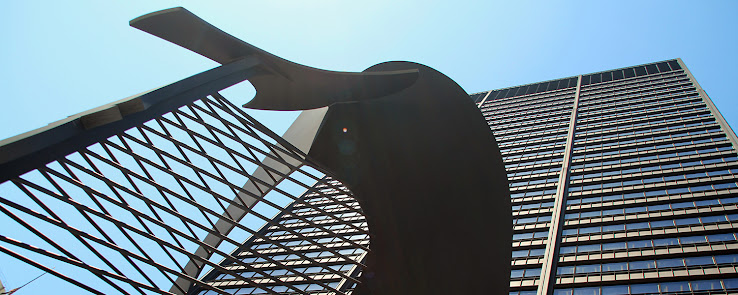 |
| Ceres - by John Storrs atop the 45-story CBOT building |
Ceres - by John Bradley Storrs
1930
Description: Aluminium, 32-foot tall
Ceres, the Roman goddess of agriculture and the patron saint of corn traders, in honor of the commodities exchange in the Chicago Board of Trade building.
Location: Chicago Board of Trade (CBOT) building
The Chicago Board of Trade commissioned the statue of Ceres by John Storrs for the buildings in 1930.
 |
| The Ceres sits atop the Chicago Board of Trade (CBOT) bldg. |
Ceres, the Roman goddess of agriculture and the patron saint of corn traders, stands atop the 45-story Chicago Board of Trade (CBOT) building in honor of the commodities trade inside the building. Her left hand holds a sheaf of wheat, while her right hand holds what is thought to be a bag of money.
The Chicago Board of Trade commissioned John Bradley Storrs to create the statue to sit atop the building in 1930.
Storrs was a Chicago-born artist who studied at the Pennsylvania Academy of Fine Arts and the School of Art Institute of Chicago (SAIC). Storrs studied with Lorado Taft at the Art Institute of Chicago. In 1912 he became a student and assistant of Auguste Rodin in Paris, France, through whose influence he grew out of his early academic training to become one of America's leading modernist sculptors.
In the 1920s and 1930s, Storrs was established as a leading American modernist sculptor. He moved away from naturalism towards geometric constructivist forms and began to work with metals other than bronze. He moved from traditional style to machine-like sculpture for which he is best known.
Storrs chose Ceres, the Roman goddess of grain to symbolize the building's purpose as the world's largest grain exchange. But he depicted Ceres not in Classical, but in a modern Art Deco style, holding a sheaf of wheat in her left hand and a bag of money in the right hand. The statue is a highly stylized figure made up of 40 sections of geometric cast aluminum shapes. The face is an oval without features. Storrs made the statue without features believing that the building was so tall that noone would be able to see the statue's face. The statue's modern style and use of vertical lines mirror the Art Deco style of the building.
Apart from Ceres, the building's other ornamentation too communicates the activity happening inside. A Mesopotamian farmer holding grain and a Native American holding corn make several appearances around the building and represnt commidities traded in the building.
 |
| The ornamentaion reflects commodities trade in the building |
 |
| Add caption |
The marker at the Art Institute of Chicago, describes this model as..
John Bradley Storrs
Ceres - 1928
Copper alloy plated with nickel and then chrome
This sleek Art Deco sculpture of Ceres, The Roman goddess of grain and the patron saint of corn traders, is a reduced version of the monumental statue that crowns the Chicago Board of Trade building at Jackson Boulevard and LaSalle streets. John Storrs linked the sculpture to the building both visually and symbolically. The stylized fluting on the Goddess's gown echoes the vertical columns of the building. Furthermore, Ceres holds a sheaf of wheat and a grain sample bag, which is emblematic of the commerce that takes place inside the Board of Trade, the world's busiest grain exchange. Impressed with the outcome of his colossal sculpture, Storrs adapted smaller models such as this one for private collectors..



No comments:
Post a Comment